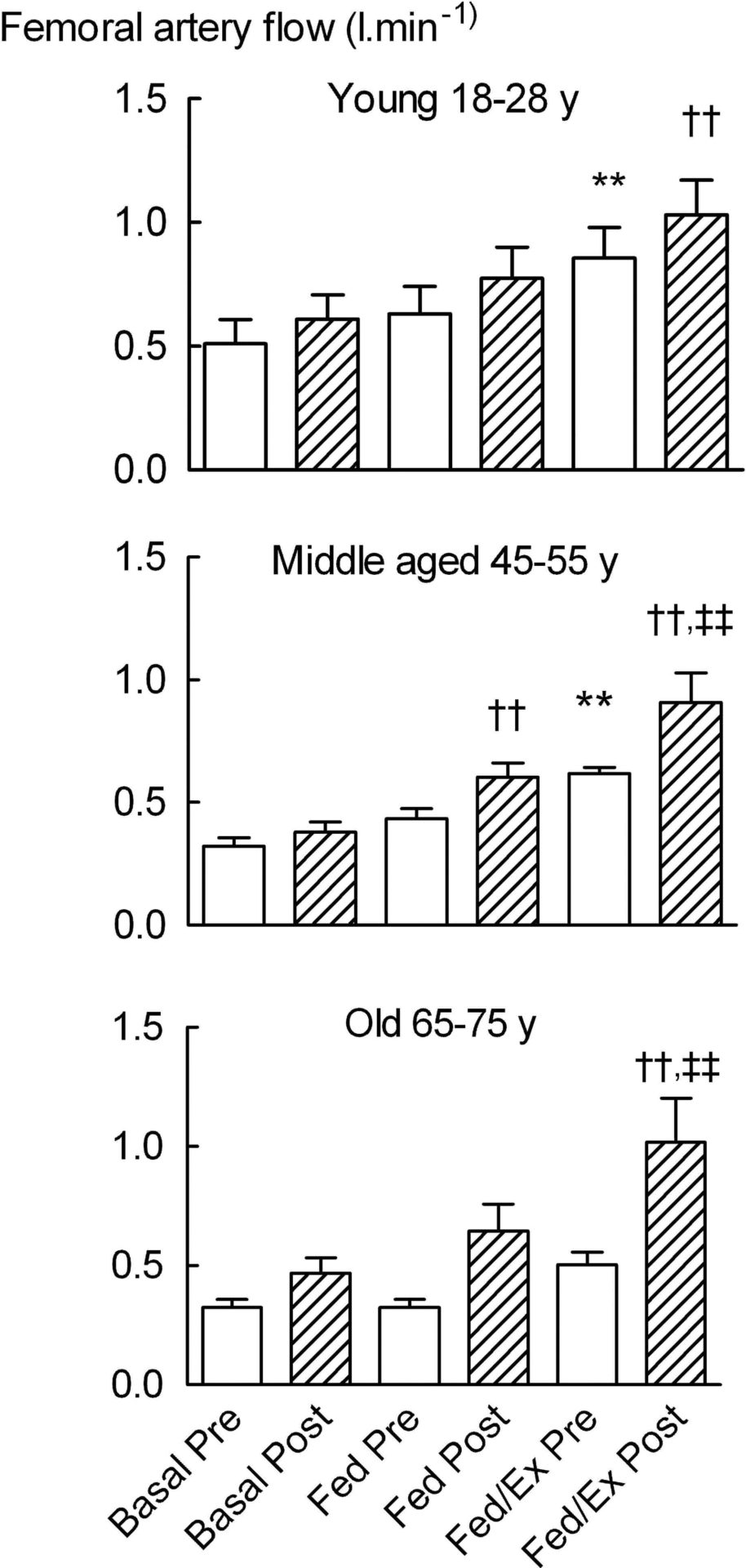Muscle blood flow can be increased by feeding and after exercise, and thus may be an important determinant of the size and efficiency of the anabolic responses to these stimuli. We have tested the hypothesis that progressive resistance exercise training would increase the response of leg blood flow to food and to the combination of an acute resistance exercise bout and food. We studied three groups of subjects (young, n=7, 5 men, 2 women, 25.2 ±1.18 y, Body mass index (BMI) 24.1±0.54; middle aged, n= 6, 3 men, 3 women, 50.9±1.5 y, BMI 27.5±1.3 and old, n=6, 3 men, 3 women, 68.8±1.3 y, BMI 25.4±0.6) who underwent 20 weeks of progressive whole body resistance exercise training (four weeks induction at 40-60% 1RM then three sessions/week at 70% 1RM, three each of upper and lower body and two torso-based exercises). Before and after training, femoral artery blood flow was measured (Doppler ultra-sound) in three conditions: (i) postabsorptive state at rest, (ii) in both legs 120 min after oral feeding (Fortisip: 16% protein, 49% carbohydrate, 35% fat) providing energy at 4.25× BMR for 2.5 h supplied as a 3×bolus and 4 further aliquots every 30 min with one leg at rest, and (iii) the other leg recovering from a previous exercise bout of 6 × 8 repetitions of leg extensions (75% 1RM). All procedures were approved by University of Nottingham ethics committee. Leg strength (extension, curl and press) increased by 23.7±4.49, 39.6±2.86 and 32.3±4.13% respectively in the young, middle aged and old groups. Basal blood flow in the middle and old groups was identical (0.32±0.03 and 0.33±0.03 l.min-1 respectively) with a strong trend for the flows to be less than in the young (0.51±0.1 l.min-1). The young group showed no training effect in leg blood flow in response to feeding and exercise (66.2±12.3% pre-training vs. 74.6±14.0% post-training). In contrast, in both the middle aged and old groups, responses to feeding plus exercise (Figure 1) were significantly enhanced by training (middle 101±16% vs. 147±32% and old 59±15% vs. 115±47%). In middle aged subjects feeding alone did not increase leg blood flow in the untrained state, but induced responsiveness after training. The results show (i) that leg blood flow responses to exercise plus food are diminished in middle aged and old subjects and (ii) are restored to the pattern seen in young subjects by resistance training.
University College Dublin (2009) Proc Physiol Soc 15, PC199
Poster Communications: In middle aged and old individuals 20 weeks of resistance training restores the increases of leg blood flow after acute exercise and feeding to values seen in young subjects.
B. Phillips1,2, W. Hildebrandt1, K. Smith1, M. Baker1, A. Gates1, P. L. Greenhaff2, M. A. Ian2, M. J. Rennie1
1. School of Graduate Entry Medicine and Health, University of Nottingham, Derby, United Kingdom. 2. Biomedical Sciences, University of Nottingham, Nottingham, United Kingdom.
View other abstracts by:
Figure 1. Effect of resistance training on increases in femoral artery blood flow after feeding or exercise plus feeding in young, middle-aged and old subjects. Values are means ±SEM. ** = P<0.01 vs. basal pre-training; †† =P<0.01 vs. basal post-training; ‡‡ = P<0.01 vs. feeding plus exercise pre-training, all via ANOVA with Tukey’s post analysis.
Where applicable, experiments conform with Society ethical requirements.

